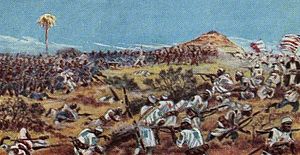| Battle of Rejaf | |||||||
|---|---|---|---|---|---|---|---|
| Part of the Mahdist War | |||||||
 Troops of the Congo Free State engage with the Mahdists at Rejaf along the Nile. | |||||||
| |||||||
| Belligerents | |||||||
|
|
| ||||||
| Commanders and leaders | |||||||
|
|
| ||||||
| Strength | |||||||
|
800 Congolese regulars 500 Azande lancers | 2,000 Mahdist rebels | ||||||
| Casualties and losses | |||||||
| Relatively light | Several hundred killed | ||||||
The Battle of Rejaf, also known as the Battle of Bedden, was fought on 17 February 1897 between the Belgian-led forces of the Congo Free State and Mahdist rebels in Rejaf (now in present-day South Sudan). The battle resulted in a Congolese victory and the permanent expulsion of the Mahdists from the Lado Enclave, as well as the establishment of a Belgian outpost along the Nile.
King Leopold II, the Belgian king and ruler of the Congo Free State, acquired the Lado Enclave in South Sudan from Britain in 1894 as part of a territory exchange which gave the British a strip of land along the eastern Congo for Belgian access to the navigable Nile. However, the territory was overrun with Mahdists who had established their stronghold at the town of Rejaf, which occupied a valuable position for trade along the Nile river. After a wave of new funding from the Belgian government in 1895, King Leopold ordered an expedition to be led into the Lado Enclave to expel the Mahdists and fortify Rejaf as a strategic military and trading outpost.
The Belgian expedition, led by Commandant Louis-Napoléon Chaltin, reached the position after a month-long advance north-east towards the Mahdist stronghold. The rebels, numbering two thousand, had established a two-mile line across a range of hills, giving their numerically superior forces a tactical advantage over Chaltin's eight hundred men. After a failed flanking maneuver by the Mahdists, Chaltin's forces stormed the heights and dislodged the defenders. The Congolese companies pursued the retreating Mahdists back towards the town of Rejaf, where a final defense was made and similarly defeated.
The victory, achieved at relatively little cost, cleared the Lado Enclave of Mahdists and secured Rejaf as a Belgian base for future operations in the surrounding territories and along the Nile. Rejaf became the seat of government within the Lado Enclave, and remained as such when the British eventually reclaimed the territory in 1910.